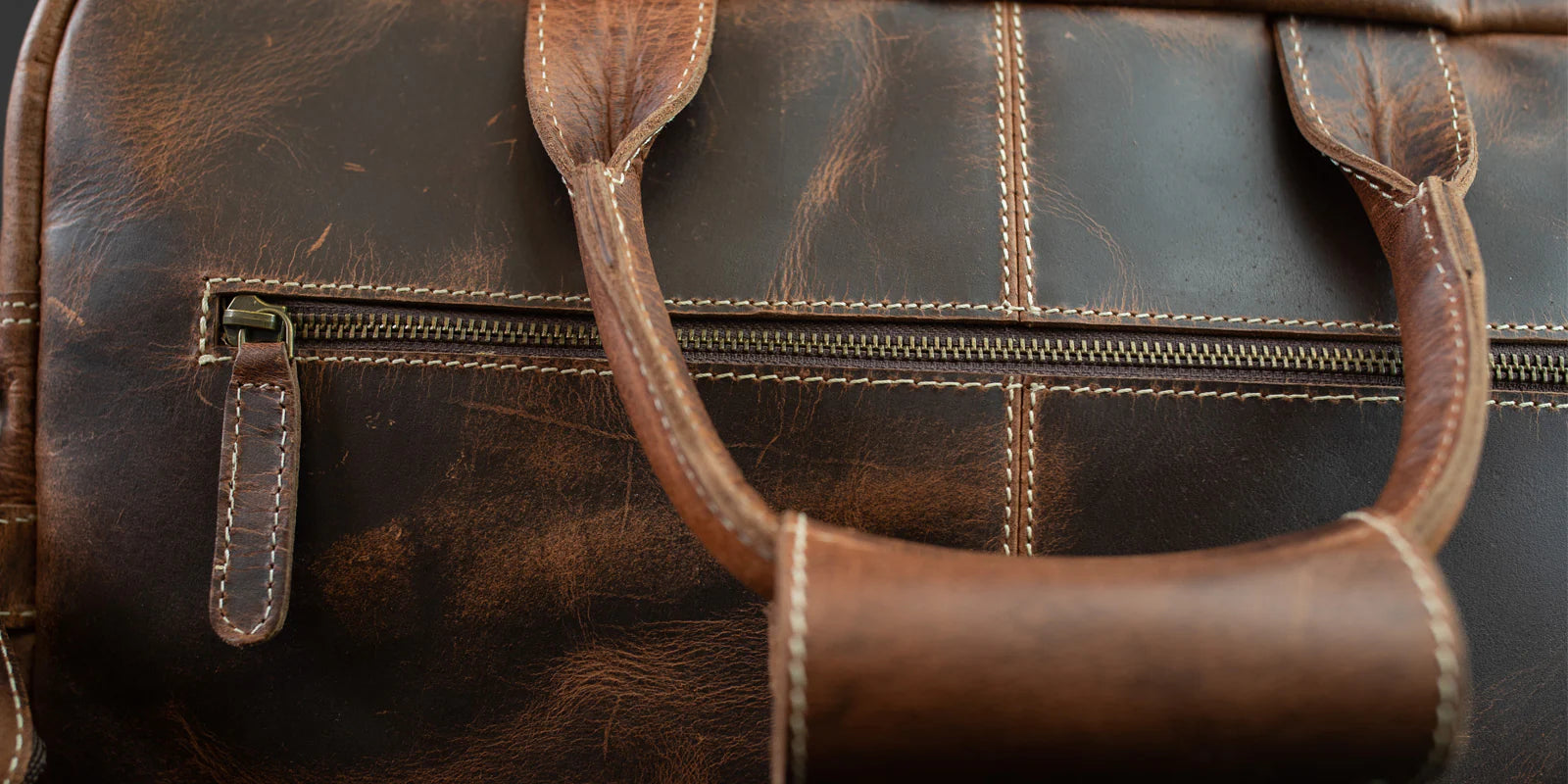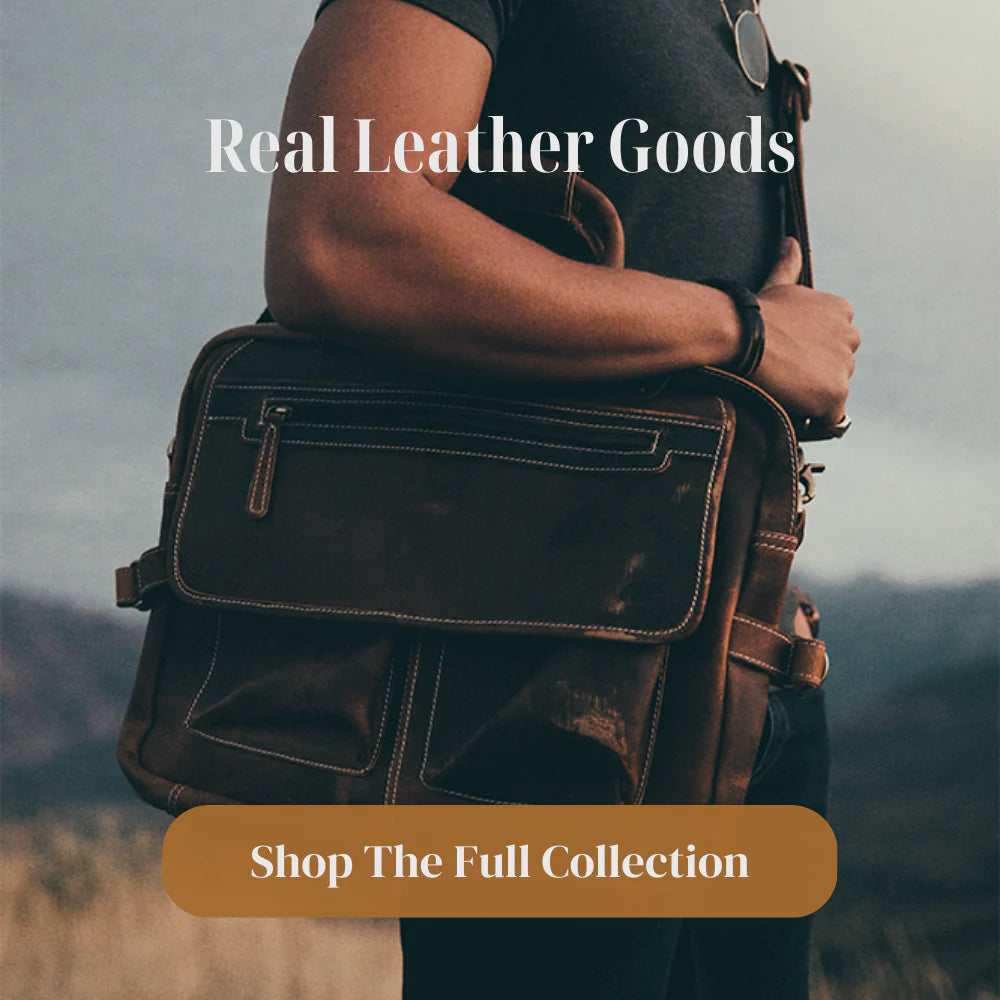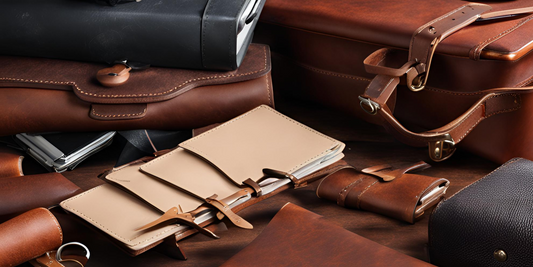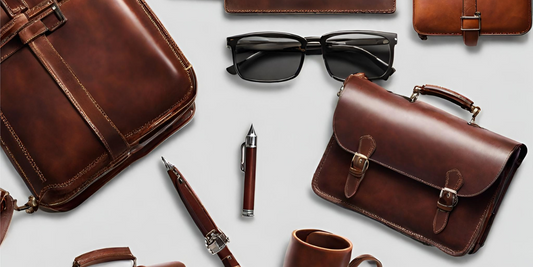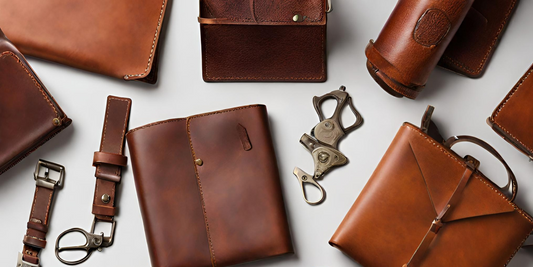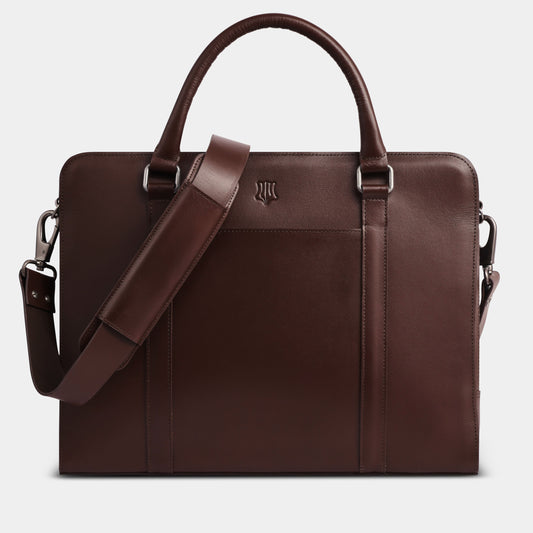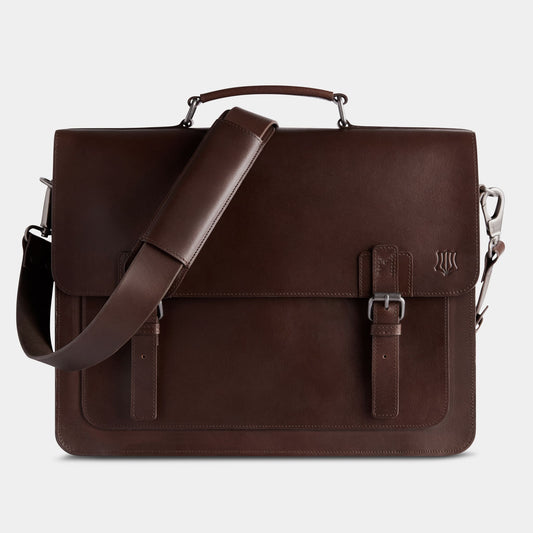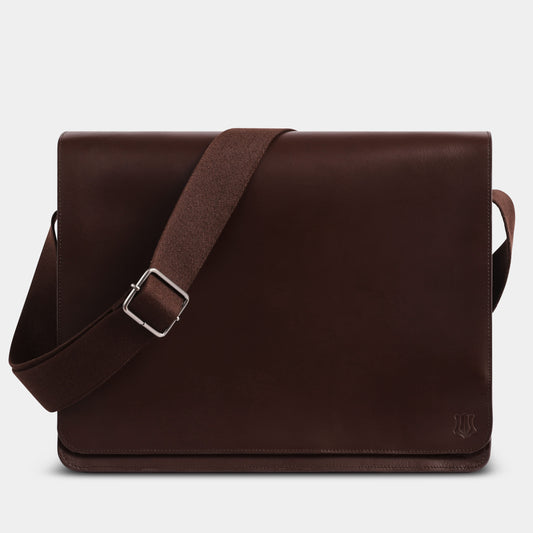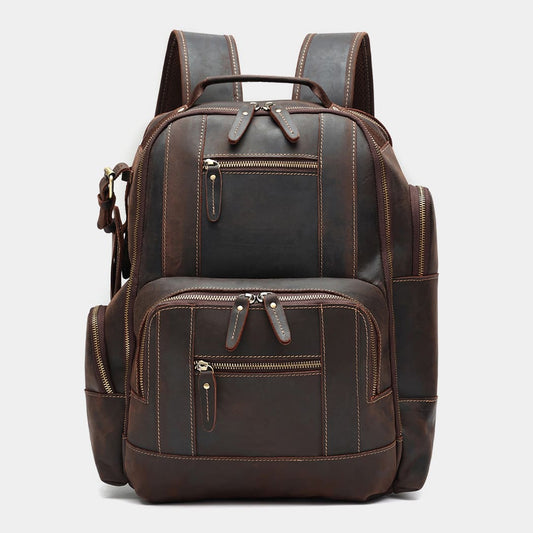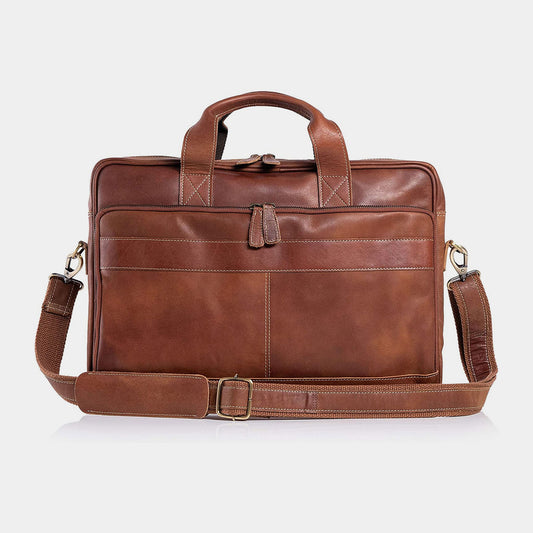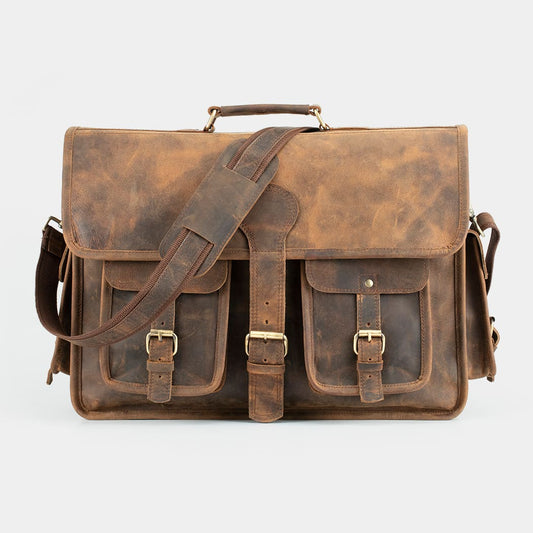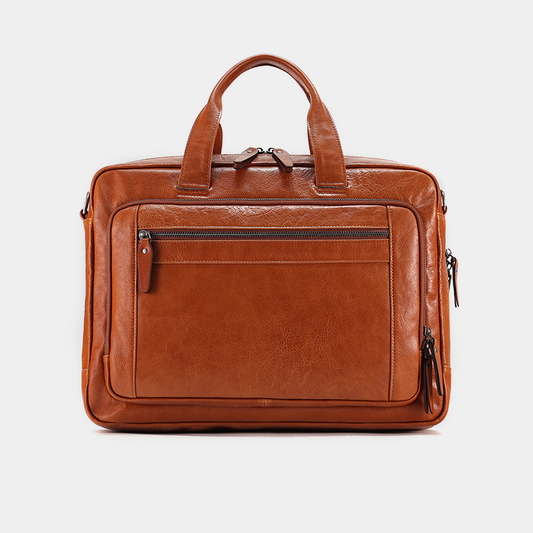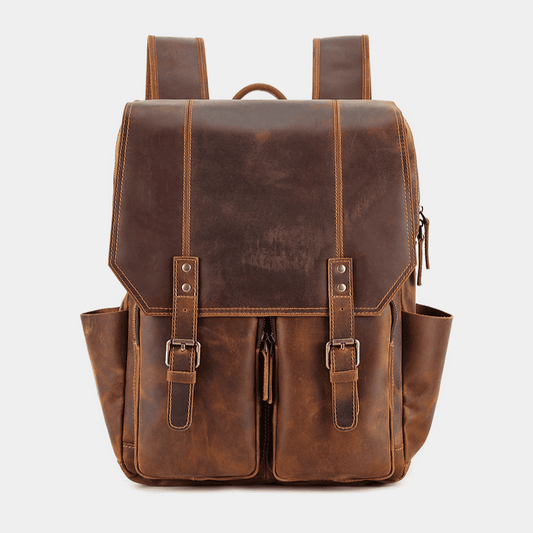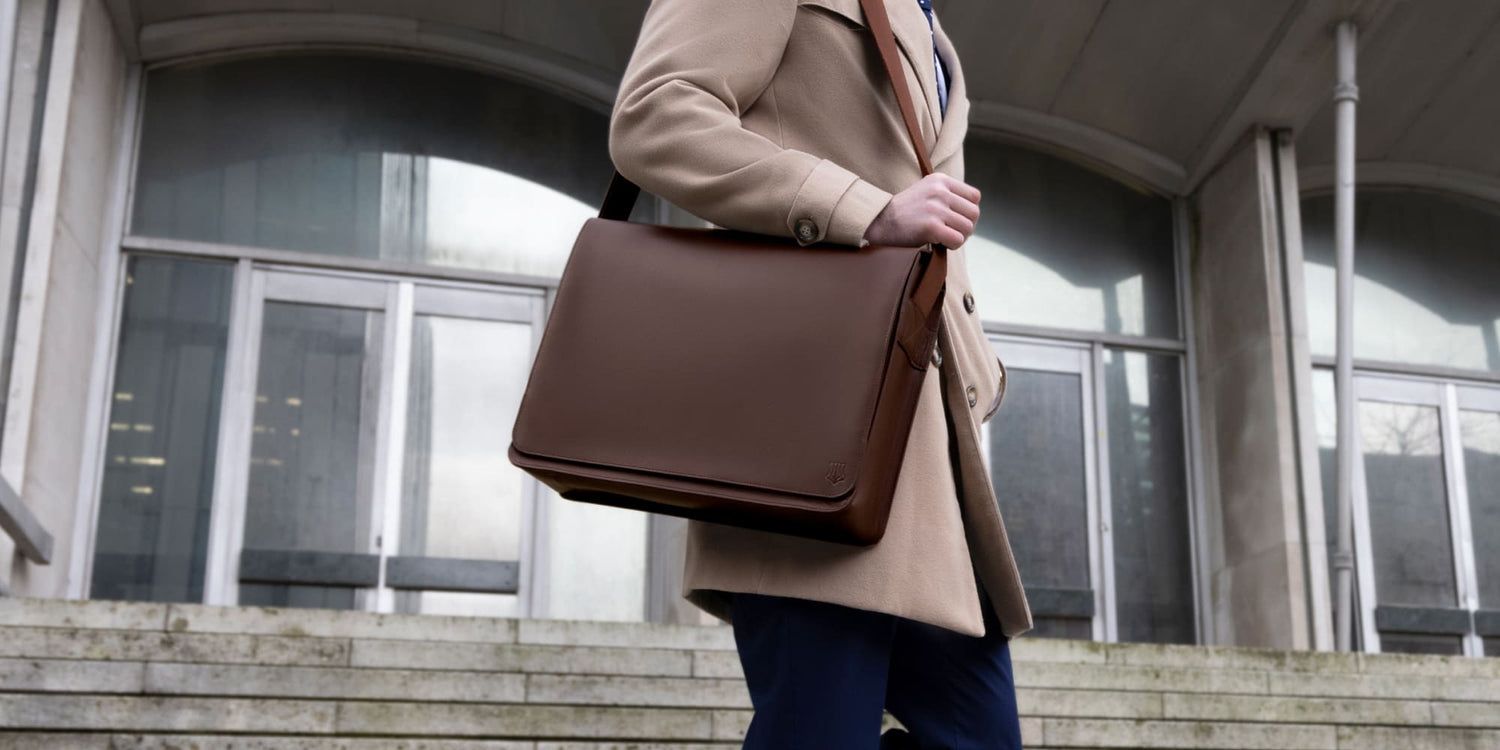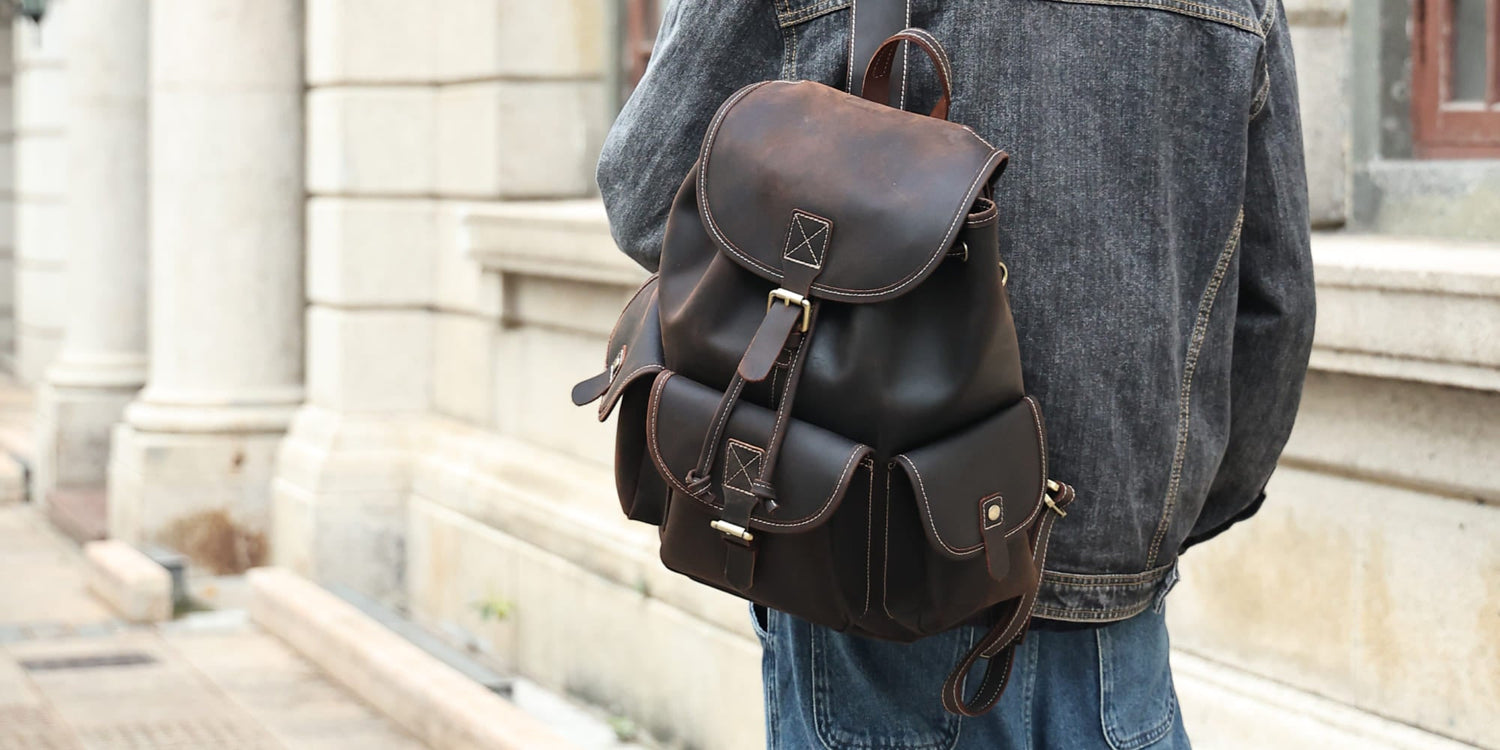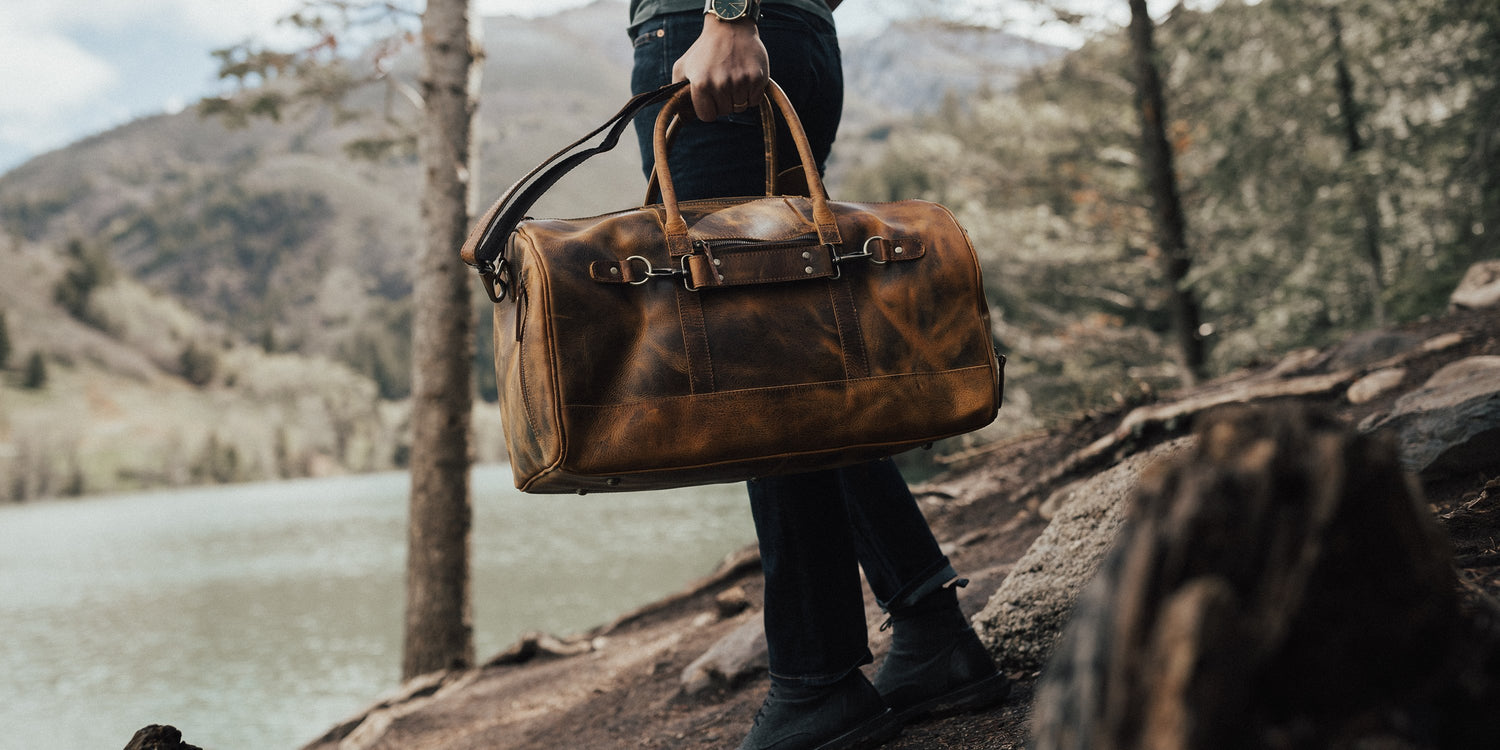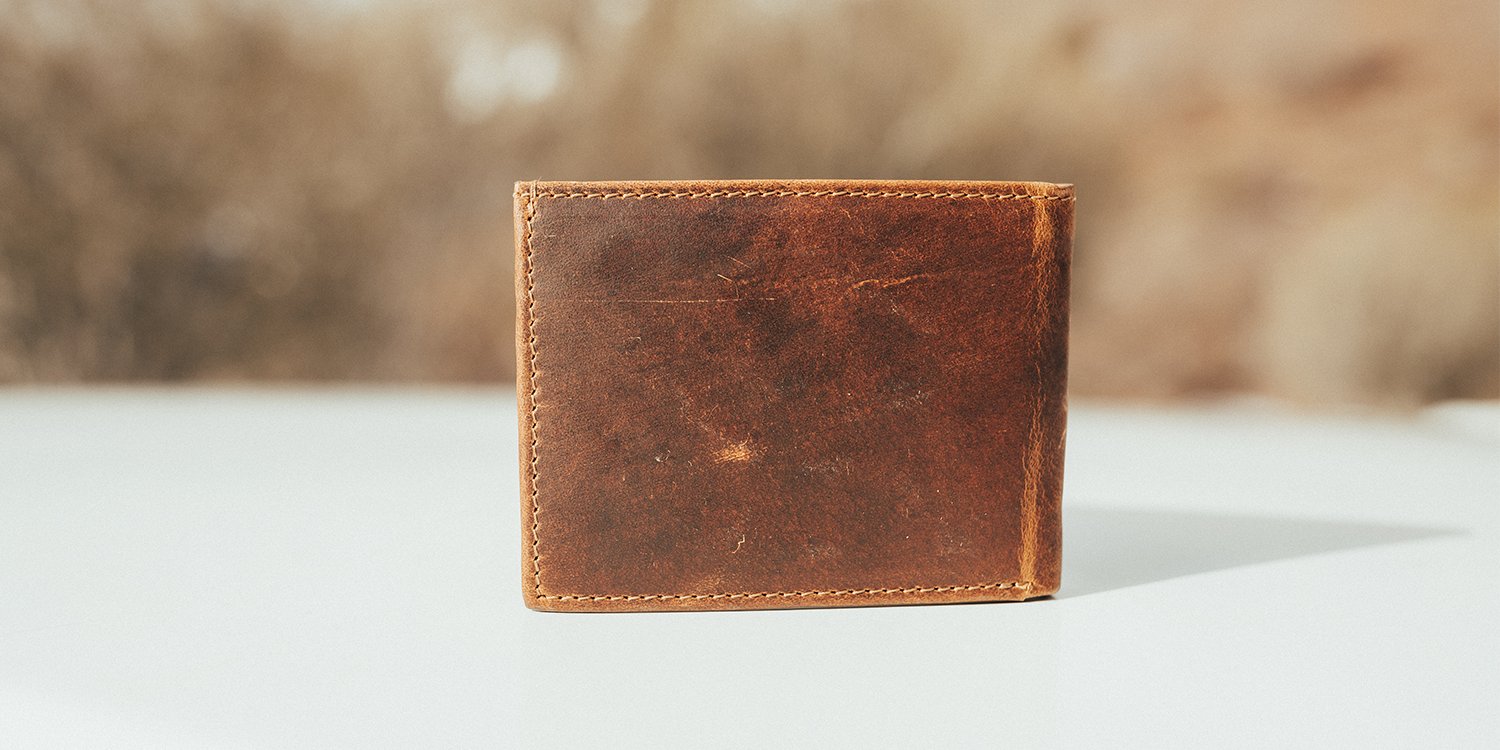Step into a realm where craftsmanship meets creativity, and luxury is a way of life.
With our comprehensive guide to leather types, you'll uncover the perfect match for your style and personality.
Get ready to elevate your wardrobe and accessories with the finest quality materials on the market.
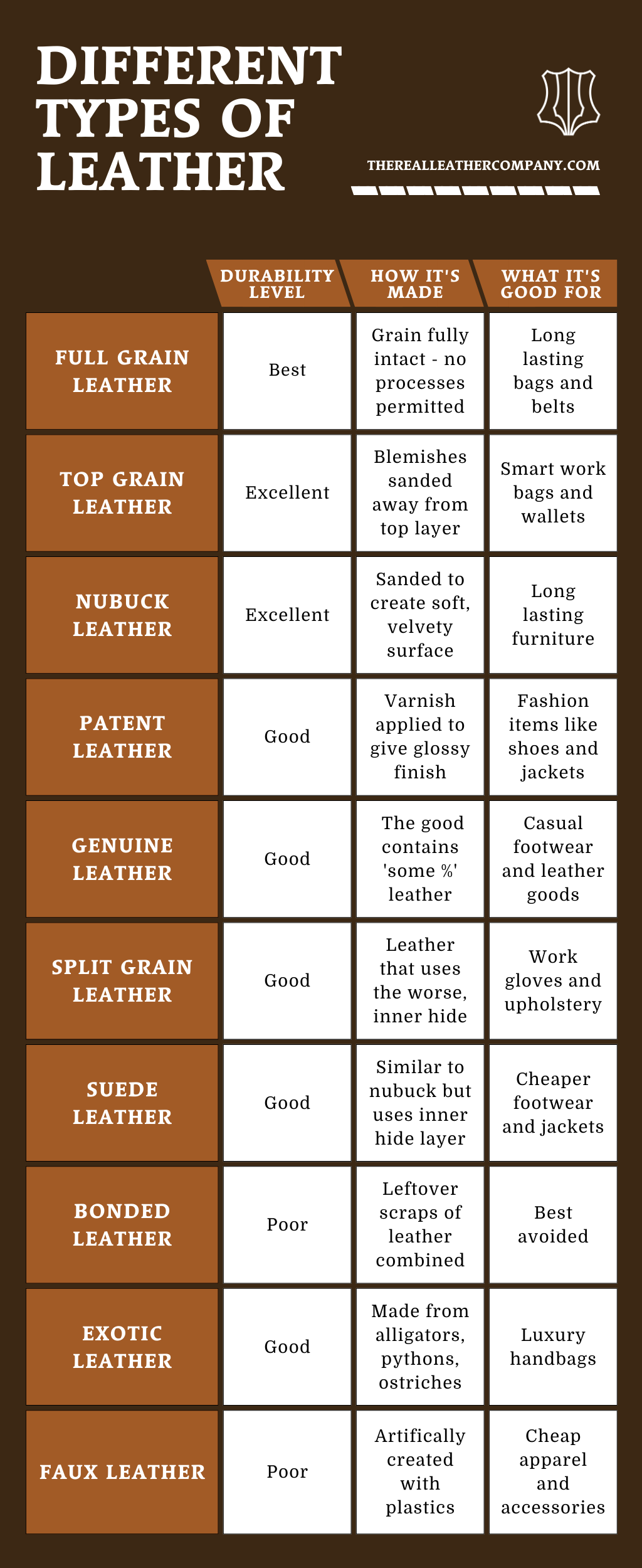
1. Full Grain Leather
Full grain leather is the highest quality of leather available.
It is the highest grade and regarded as the best out there.
Full grain leather is the very top layer of the hide.
In order for leather to be considered full grain, the grain must be fully intact.
No sanding or buffing can be applied, not even to remove natural imperfections.
As full-grain leather is not modified in any way, naturally there will be some imperfections on the hide (just like human skin!) that remain on a leather good.
Whilst this may not be to everyone's taste, this means a full grain leather bag will always be unique and no two are exactly the same.
At The Real Leather Company, we like to think this gives each bag a certain character.
As the full thickness of the hide is used in full grain leather, it is notoriously difficult to work with and requires exceptional artisanal skill.
Only approximately 1-13% of any cowhide can be used for full grain leather.
For these reasons, full grain leather is the most expensive type to work with and buy.
Keeping the full-grain intact does give certain advantages such as best available strength, breathability and durability.
Full grain leather does not wear out like other types but develops a natural patina over time.
You can generally expect a full grain leather bag to have the best longevity - a bag with this leather will be a real companion for life.
Does this sound like the leather for you? Check out our collection of full grain leather bags.

2. Top Grain Leather
Top grain leather (sometimes called corrected grain leather) is considered the second-best quality of leather available.
Generally, this will be the type that is used most in high-end leather bags.
If full grain leather is corrected in any way, it then becomes top grain leather.
This means that top grain leather can have imperfections removed, and sanding or buffing techniques can be applied.
This often means top grain leather bags have a smooth, uniform appearance.
Although top grain leather bags sometimes lose that uniqueness you get from full grain leather, for many, this is considered a good trade-off to have imperfections removed.
As corrections are possible with top grain leather, this type is often thinner, making it easier to work with and generally a little more affordable than full grain.
Finish coats are usually applied to top grain leather bags.
Whilst this reduces breathability, can lead to stretching and prevents the formation of a natural patina, this coat will protect the bag from stains or blemishes that would sink right into a full grain leather bag.
Looking for something along these lines? Check out our top grain leather bags.

3. Nubuck Leather
Nubuck leather is similar to suede but is made from the top grain of the animal skin, giving it a finer texture and greater durability.
It is sanded or buffed on the grain side to create a soft, velvety surface.
Nubuck leather is commonly used in footwear, handbags, and furniture upholstery.
It has a luxurious appearance and feel, but requires regular maintenance to keep it looking its best.
Due to its delicate nature, nubuck leather is susceptible to staining, water damage, and wear over time.
It is important to protect nubuck leather products with waterproof sprays and regular cleaning to maintain their appearance and longevity.
Despite these challenges, nubuck leather offers a unique combination of elegance and durability that is prized by consumers and designers alike.
Nubuck leather products may require special care and attention to preserve their natural beauty and texture.
Regular brushing with a nubuck brush can help to restore the nap and remove surface dirt and debris.
Additionally, specialized nubuck cleaning products can be used to treat stains and maintain the softness and suppleness of the leather.
With proper care, nubuck leather products can provide years of enjoyment and style.

4. Patent Leather
Patent leather is a type of leather that has been treated with a glossy, shiny finish.
It is commonly used in footwear, handbags, and accessories for its distinctive appearance.
Patent leather is highly durable and resistant to water and stains, making it a popular choice for formal wear and special occasions.
The glossy finish of patent leather is achieved through a process of applying multiple layers of lacquer or varnish to the surface of the leather.
This creates a smooth and reflective surface that enhances the appearance of the leather and gives it a luxurious sheen.
Patent leather is available in a wide range of colors and finishes, making it a versatile option for fashion and design.
Despite its durability and water-resistant properties, patent leather requires special care to maintain its glossy finish.
It is important to protect patent leather products from scratches and scuffs by storing them in a cool, dry place and avoiding exposure to abrasive materials.
Regular cleaning with a soft, damp cloth can help to remove surface dirt and maintain the shine of patent leather products.
Overall, patent leather offers a sleek and sophisticated look that is perfect for adding a touch of glamour to any outfit or accessory.
Its durability and versatility make it a popular choice for consumers and designers alike.
A common, but somewhat similar alternative is aniline leather and semi-aniline leather.
Crafted from premium hides, aniline leather undergoes minimal processing, allowing the natural characteristics of the leather to shine through.
Similarly, semi-aniline leather retains the authenticity of the hide while receiving a light protective topcoat to enhance durability.
With proper care, patent leather products can provide years of style and elegance.

5. Genuine Leather
Genuine leather is a catch all term that has become popular in the leather industry.
If a product is marked as genuine leather, that just means it contains some amount of real leather.
It could be 100% real leather or it could be 1% real leather.
Goods marked as genuine leather are not a guarantee, or even an indication, of quality.
Genuine leather is made from leather that remains after the top layer is split off for full grain and top grain leathers.
This lower layer is naturally not as tough or strong as the top layer. This feeds through to any genuine leather goods, making them not as strong or durable as full grain or top grain.
After the tanning process, either chromium tanned leather or vegetable tanned leather is produced.
This leather would not have a natural skin finish. Artificial leather finishes such as soluble dyes or pigmentation are required to get it looking that way.
A combination of artificial grains, spray painting and pattern embossing is usually applied to the surface to make it look more like real natural, top hide leather.
As artificial processes are permitted with genuine leather, imperfections can be removed, and often, genuine leather bags can look very similar to top grain leather bags.
Genuine leather is often tough as it resides under the top layer.
This gives extended durability. Note that this type of leather will usually have compromised breathability due to the artificial processes required.
As genuine leather does not require the rarer top hide and can be artificially altered, this type is usually more affordable than either full grain or top grain.

6. Split Grain Leather
Split grain leather is a type of leather that is produced from the fibrous inner layer of the hide after the top grain layer has been separated by the tanneries.
While not as high quality as full grain or top grain leather, split leather still possesses some desirable characteristics.
It is more affordable than full grain or top grain leather and can be used to create a variety of leather goods such as belts, wallets, and upholstery.
Split grain leather is known for its durability and resistance to wear and tear.
It has a rougher texture compared to full grain or top grain leather, making it suitable for casual or rugged applications.
Split grain leather is often used in products where strength and durability are more important than aesthetics, such as work boots, tool belts, and automotive upholstery.
Despite its lower cost and versatility, split grain leather may lack the natural beauty and aging characteristics of higher quality leathers.
It is important to note that split grain leather may also be more prone to cracking or peeling over time, especially if not properly cared for.
Overall, split grain leather offers a cost-effective option for consumers seeking durable and functional leather products.
7. Suede Leather
Suede leather is split from the corium, then created from the underside of the animal hide, giving it a soft and fuzzy texture.
It is less durable than other types of leather and is prone to staining and water damage.
Suede leather is commonly used in garments, accessories, and upholstery.
It has a unique appearance and feel that adds a touch of luxury to any product.
Suede leather requires special care and maintenance to preserve its softness and appearance.
It is important to protect suede products from moisture and dirt by applying a waterproof spray and avoiding exposure to harsh chemicals or abrasive materials.
Regular brushing with a suede brush can help to restore the nap and remove surface dirt and debris.
Despite its delicate nature, suede leather offers a luxurious look and feel that is unmatched by other materials.
It has a timeless appeal that adds sophistication and style to any outfit or space.
Suede leather products are available in a wide range of colors and finishes, making them versatile options for fashion and interior design.
With proper care, suede leather products can provide years of enjoyment and beauty.

8. Bonded Leather
Bonded leather, sometimes referred to as reconstituted or blended leather, is generally considered to be the lowest grade of leather available.
Generally, leftover bits of leather scraps are ground to a pulp then bonded together with chemicals and fillers.
Many would not consider this a real leather as so many artificial chemicals, fillers, spray paints and embossing coats are required to get this looking like full grain or top grain leather.
Often, at the end of the process, the actual percentage of real leather used in the material can be low.
As very little real leather is often used in this material, bonded leather tends to fall apart very quickly and will not have good longevity.
If you are looking for a leather bag that will be a companion for years, we would not usually recommend purchasing a bonded leather bag.
You will find that because bonded leather is made from leftover bits of leather it is generally the cheapest type of leather available.

9. Exotic Leather Types
Exotic leather encompasses a variety of unique and rare materials sourced from unconventional sources such as reptiles, mammals, and even fish.
These exotic leathers offer distinctive textures, patterns, and colors that set them apart from traditional leather options.
While exotic leathers are prized for their exclusivity and luxury, they also raise ethical and sustainability concerns due to their sourcing methods.
One popular type of exotic leather is crocodile or alligator leather, known for its distinctive scale patterns and durability.
Crocodile leather is commonly used in luxury accessories such as handbags, wallets, and belts.
Another sought-after exotic leather is python, which features a striking natural pattern and soft texture. Python leather is often used in high-end fashion garments and accessories.
Other exotic leather types include ostrich, known for its unique quill follicle pattern and supple feel, and stingray, prized for its durability and distinctive pebbled texture.
These exotic leathers are used in a variety of luxury products, from footwear and upholstery to watch straps and small leather goods.
While exotic leathers offer unparalleled beauty and quality, it is important for consumers to consider the ethical and environmental implications of their purchase.
Many exotic leather sources are subject to regulations aimed at protecting endangered species and ensuring sustainable harvesting practices.
By choosing reputable suppliers and brands that prioritize ethical sourcing and transparency, consumers can enjoy the luxury of exotic leather with peace of mind.

10. Faux Leather
Faux leathers, also known as synthetic leather or artificial leather, are manufactured materials designed to mimic the look and feel of real leather without using any animal products.
These materials are popular alternatives for individuals who prefer cruelty-free or vegan options, as well as those looking for more affordable alternatives to genuine leather.
Faux leathers are typically made from a variety of synthetic materials such as polyurethane (PU) or polyvinyl chloride (PVC).
They can be engineered to resemble different types of leather textures, including smooth, grainy, or embossed finishes.
While faux leathers may not possess the same durability and longevity as genuine leather, they often offer greater versatility in terms of color, pattern, and texture options.
Despite their synthetic composition, modern advancements in manufacturing techniques have led to faux leathers that closely resemble the look and feel of real leather.
Additionally, faux leathers are generally more resistant to moisture and staining, making them easier to clean and maintain.
Overall, faux leathers provide consumers with a cruelty-free and budget-friendly alternative to traditional leather products.

Choosing between the Different Types of Leather
When selecting the perfect leather for your needs, it's essential to consider factors such as durability, aesthetics, and intended use.
Each type of leather offers unique characteristics that make it suitable for specific applications.
Let's explore which types of leather are best suited for different products:
Full Grain Leather
Best for durable and long-lasting leather goods like bags, belts, and wallets due to its strength and natural markings.
Top Grain Leather
Ideal for high-quality leather bags, belts, and wallets, offering a refined appearance and good durability at a more affordable price.
Nubuck Leather
Suited for high-end products like footwear, jackets, and upholstery, providing a luxurious texture and appearance.
Patent Leather
Perfect for formal footwear, handbags, and accessories, adding a glossy finish for a sophisticated look.
Genuine Leather
Practical for casual footwear, small leather goods, and leather furniture, offering affordability but may lack longevity.
Split Grain Leather
One of the best leather types for casual footwear, work gloves, and upholstery, providing durability at a lower cost.
Suede Leather
Ideal for fashion footwear, jackets, and interior accents, offering a soft and luxurious texture.
Bonded Leather
Best avoided for most leather goods due to its low durability and lower quality.
Exotic Leather
Prized for luxury items like shoes, bags, and watch straps, offering unique textures and patterns for a standout look.
Faux Leather
Provides versatile options for a wide range of non-natural leather goods including apparel, accessories, and upholstery, offering cruelty-free and budget-friendly alternatives.
Care and Maintenance of Leather Goods
Proper care and maintenance are essential to ensure the longevity and beauty of your leather goods.
Follow these tips to keep your items looking their best:
1. Regular Cleaning
Wipe leather goods with a soft, damp cloth to remove surface dirt and dust.
Avoid using harsh chemicals or abrasive cleaners, as they can damage the leather.
2. Conditioning
Apply a leather conditioner periodically to keep the leather moisturized and supple.
This helps prevent drying, cracking, and fading over time.
3. Protection
Use a waterproof spray to protect leather goods from moisture and stains.
Be sure to test the spray on a small, inconspicuous area first to ensure compatibility with the leather.
4. Storage
Store leather goods in a cool, dry place away from direct sunlight and heat sources.
Avoid stacking or compressing leather items, as this can cause them to lose their shape.
5. Avoiding Excess Wear
Rotate the use of your leather goods to prevent excessive wear and tear on any one item.
Be mindful of sharp objects or rough surfaces that could scratch or damage the leather.
6. Professional Cleaning
For stubborn stains or deep cleaning, consider taking your leather goods to a professional cleaner who specializes in leather care.
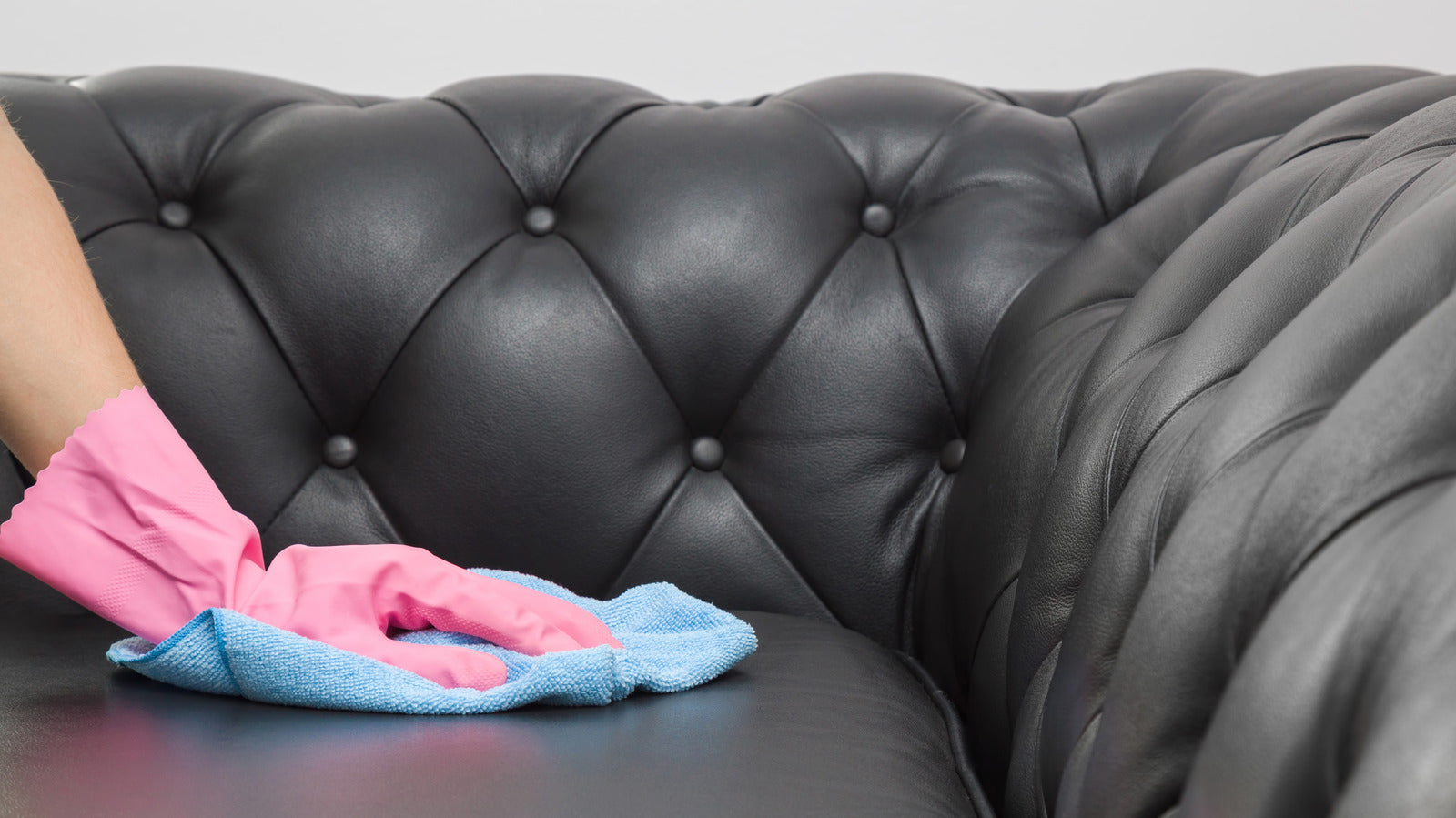
FAQs
1. What is the difference between full grain and top grain leather?
Full grain leather is the highest quality, featuring the entire thickness of the hide and retaining its natural grain.
Top grain leather, on the other hand, has had the top layer sanded or buffed to remove imperfections, resulting in a smoother surface.
2. Is genuine leather good quality?
While genuine leather is real leather, it is typically of lower quality compared to full grain or top grain leather.
It is made from the layers beneath the top grain and may undergo artificial processes to enhance its appearance.
3. What is the difference between nubuck and suede?
Nubuck leather is made from the top grain of the hide and is buffed to create a soft, velvety surface.
Suede, on the other hand, is made from the underside of the hide and has a fuzzy texture.
4. Are bonded leather products durable?
Bonded leather, made from leftover bits of leather scraps bonded together with chemicals, tends to have poor durability and longevity.
It is not recommended for items that require durability.
5. Can you use any leather for outdoor furniture?
Real leather is not waterproof, so not recommended for outdoor upholstery or furniture.
However, some vegan and faux leather have plastics applied to make them waterproof. In some cases, PU leather and PVC leather can be suitable for outdoor furniture.
6. Can faux leather products look like real leather?
Yes, modern advancements in manufacturing techniques have led to faux leathers that closely resemble the look and feel of real leather.
They offer a cruelty-free and budget-friendly alternative to genuine leather products.
7. What is the difference between aniline and semi-aniline leather?
Aniline leather undergoes minimal processing and retains the natural characteristics of the hide, while semi-aniline leather receives a light protective coating to enhance durability while preserving the authenticity of the hide.
8. How can I care for my leather goods?
Regular cleaning with a soft, damp cloth and the application of a leather conditioner can help nourish the leather and protect it from the elements.
It is also important to store leather goods in a cool, dry place away from direct sunlight and heat sources.
